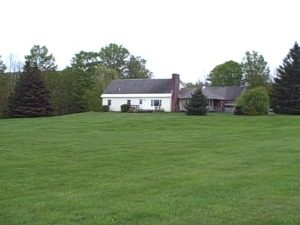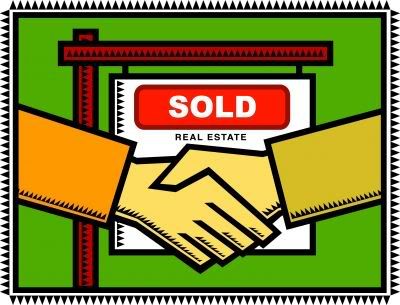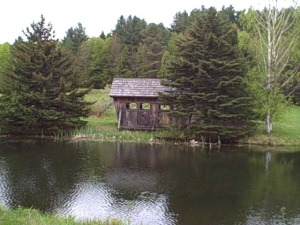


View the Falls!

FRAME THE VIEW

Circular Driveway
Maple Hill is one of Vermont’s most beautiful venues. Although only 7 minutes from Jackson gore, this property offers serenity, privacy and splendor. The 4-bedroom, 4-bath Georgian Ranch fits right into the 18.63 acres which include a pond, a pool, exceptional landscaping and majestic mountain views. A great room features a Rumford fireplace abd the kitchen has granite countertops and commercial-grade appliances. The master suite includes the bedroom, a sitting room, a fireplace and a whirlpool. With a full, walk-out lower level, this home’s 5,200 s.f. will comfortably and elegantly accommodate your family and friends. More land is available – making a total of approximately 65 acres – so bring the horses! There are wonderful meadows for riding, hiking, cross-country skiing and communing with nature’s best in beautiful southern Vermont. Offered for: $1,295,000.00
Just Listed! 4 Bedroom, 3 Bath – 21.46 acres, plus a Covered Bridge!

Offered for $650,000 – including the bridge and pond.
Just Listed in Chester, Vermont
- Fabulous Open Floor Plan
Space and Sunshine
Chester – Fabulous 3 bedroom, 2 bath, open floor plan contemporary in one of Vermont’s favorite towns. Many upgrades within past year including: kitchen, baths, flooring and all new windows and doors. Close to skiing – beat the Sunday traffic home from Okemo! $385,000.00
Reasons To Buy An Okemo Mountain Home In 2009

Now the market has shifted. The strong sellers’ market is a thing of the past and it is the sellers who are jumping through hoops. Buyers are calling the shots with offers that include home inspections; requests that closing costs, homeowner association fees and inspection fees be paid by the seller; decorating allowances; home improvement; and prices far below the asking price.
So why are Okemo Mountain home buyers hesitating? Fear of a tanking economy, falling home prices and job instability are concerns for many potential home buyers. But if you are financially stable and plan to stay in a home for at least five years, there are 5 top reasons to buy an Okemo Mountain home in 2009:
1. Homes are affordable.
According to the National Association of Realtors‘ housing affordability index, homes were more affordable in December than at any other point since the group started the index in 1970. The affordability index is a measure of the relationship between home prices, mortgage interest rates and family income.
A recent report from Moody’s Economy.com predicted that house prices will stabilize by the end of this year. The Office of Federal Housing Enterprise Oversight’s Web site has a house price calculator that can help. Visit the calculator.
2. There are lots of homes to choose from.
The slow down in the housing market has caused homes to stay on the market longer, creating a huge inventory. There was a 9.6-month supply of unsold existing homes in January given that month’s sales pace, according to NAR.
A large inventory gives buyers more selection, driving down prices. As buyers start to jump back into the market, the inventory will shrink and cause prices to start going back up. The time to get the best deal is before most buyers buy.
3. Builders are offering perks.
New home builders are offering price reductions, free upgrades and other perks such as free appliances, homeowners’ fees being paid, lower interest rates decorating allowances. Once their inventory shrinks, these perks will go away.
4. Interest rates are at historical lows.
Lenders are not lending as freely, but if you have good credit and the needed down payment, mortgage interest rates are historically low and hovering around 5 percent.
5. There is an $8000 tax credit
If you are a first-time Okemo Mountain home buyer, you will qualify for an $8000 federal tax credit if you buy before December 1, 2009. Unlike the previous tax credit offered in 2008, this does not have to be repaid. Extra money comes in handy when buying a home.
Trying to decide if buying an Okemo Mountain home in 2009 is right for you? Give me a call. I’m glad to review your situation with you.
Low Cost Fixes Sell Okemo Mountain Homes
If you have a home that only you can love, you will benefit for these low cost fixes to getting your Okemo Mountain home sold quickly. We don’t live in a house the way we sell a house. Buyers aren’t interested in seeing dirty socks lying around or dirty dishes in the sink. Below are a list inexpensive things, from Realtor Magazine, that you can do to make buyers fall in love with your Okemo Mountain home.
1. Move it.
Simply rearranging the furniture can reenergize a room. Add and remove furniture, lamps, rugs, and accessories from other parts of the house to create a whole new look. Mirrors are particularly useful when it comes to updating a room. Try one out in different rooms to see where it fits best. Even just moving a mirror to a different wall can create a more welcoming feel.
2. Plant it.
Houseplants are a generally undervalued design component that can add texture, warmth, and color to any room. Just drop plants in their store containers into decorative planters. Small plants can be moved easily and regrouped to change a room’s look, while larger ones make a statement on their own.
Group plants together of differing heights, fullness, and color for the most dramatic effect. It’s important to have plants that are well maintained and in tip-top condition.
3. Paint it.
Paint is one of the easiest and most cost-effective ways to make a substantial change. Use dramatic colors in powder rooms and dining rooms, and more neutral colors in living spaces. When selecting colors, “be sure to ask, ‘What am I trying to do? How do I want this to feel?'” And always, always do a test before you paint the whole room.
4. Organize it.
Clutter just happens. So neaten up! A variety of organizing tools can make a space feel polished while maintaining utility. Hooks and shelves inside the door give people a place to hang coats and keys, while canvas bins or natural baskets help contain magazines and mail. Just a row of hooks pre-attached on a board is so easy to install. And shelves are a great way to neatly display collectibles.
5. Hide it.
Have a banged-up wall? It may be easy to camouflage. Paintable wallpaper will smooth out an uneven wall or hide minor dents and dings. Adventurous home owners can even try a simple two-step painting process for a more complex finish. A apply a solid base coat, then a glaze.
Your intent should never be to mislead buyers; be sure to disclose flaws that would affect home value.
6. Replace it.
Cabinet handles, switch plates, and other small pieces of housing hardware can update a home for just a few dollars a piece. Scan each room to see what looks worn or outdated and then replacing it. Inexpensive quick-connect faucets can make upgrading the look of your bathroom a snap. Just be sure to measure before you go to the hardware store. Some sinks are drilled for an eight-inch spread. Others require just four inches.
And don’t forget the toilet seat. Fresh towels and a new toilet seat go a long way toward making a bathroom feel clean and new.
7. Light it.
Lighting can have a major impact on a home’s look and feel. Whether a room seems dark or too bright and harsh, try “layering” the lighting by adding accent pendants and lamps. Make sure they have independent controls, so that you can turn them on and off at will.
Light is such a mood setter. You can create a cozy feel just by turning down the lights. Add dimmers in the dining room, bathrooms, kitchen, and even the hallways for less than $4 each. Then adjust the lighting to create the mood you want.
8. Clean it.
Turn a critical eye to the flooring to make sure it’s up to snuff. Scrub grout and seal natural stone. Rub out scratches and nicks on wood floors with scratch cover. Get down on your hands and knees and detail the floors. It takes a little elbow grease, but the results are well worth it. Vinyl flooring is a bit harder to spruce up but usually can be replaced easily and inexpensively.
Interested in selling your Okemo Mountain home? Give me a call, I’m glad to help!
Is My Okemo Mountain Second Home Tax Deductible
Is My Okemo Mountain Second Home Tax Deductible?
This is the season when Okemo Mountain second homeowners are wondering just what second home expenses can be deducted on their federal income taxes. The best way to share this information with you is to share with you an article from Kiplinger.com. This should answer all Okemo second homeowner questions:
Mortgage interest. If you use the place as a second home — rather than renting it out as a business property — interest on the mortgage is deductible just as interest on the mortgage on your first home is. You can write off 100% of the interest you pay on up to $1.1 million of debt secured by your first and second homes and used to acquire or improve the properties. (That’s a total of $1.1 million of debt, not $1.1 million on each home.) The rules that apply if you rent the place out are discussed later.
Property taxes. You can deduct property taxes on your second home, too. In fact, unlike the mortgage interest rule, you can deduct property taxes paid on any number of homes you own.
If you rent the home. Lots of second-home buyers rent their property part of the year to get others to help pay the bills. Very different tax rules apply depending on the breakdown between personal and rental use.
If you rent the place out for 14 or fewer days during the year, you can pocket the cash tax-free. Even if you’re charging $5,000 a week, the IRS doesn’t want to hear about it. The house is considered a personal residence, so you deduct mortgage interest and property taxes just as you do for your principal home.
Rent for more than 14 days, though, and you must report all rental income. You also get to deduct rental expenses, and that gets complicated because you need to allocate costs between the time the property is used for personal purposes and the time it is rented.
If you and your family use a beach house for 30 days during the year and it’s rented for 120 days, 80% (120 divided by 150) of your mortgage interest and property taxes, insurance premiums, utilities and other costs would be rental expenses. The entire amount you pay a property manager would be deductible, too. And you could claim depreciation deductions based on 80% of the value of the house. If a house is worth $200,000 (not counting the value of the land) and you’re depreciating 80%, a full year’s depreciation deduction would be $5,800.
You can always deduct expenses up to the level of rental income you report. But what if costs exceed what you take in? Whether a loss can shelter other income depends on two things: how much you use the property yourself and how high your income is.
If you use the place more than 14 days, or more than 10% of the number of days it is rented — whichever is more — it is considered a personal residence and the loss can’t be deducted. (But because it is a personal residence, the interest that doesn’t count as a rental expense — 20% in our example — can be deducted as a personal expense.)
If you limit personal use to 14 days or 10%, the vacation home is considered a business and up to $25,000 in losses might be deductible each year. That’s why lots of vacation homeowners hold down leisure use and spend lots of time “maintaining” the property. Fix-up days don’t count as personal use. The tax savings from the loss (up to $7,000 a year if you’re in the 28% tax bracket) help pay for the vacation home. Unfortunately, holding down personal use means forfeiting the write-off for the portion of mortgage interest that fails to qualify as either a rental or personal-residence expense.
We say such losses might be deductible because real estate losses are considered “passive losses” by the tax law. And, passive losses are generally not deductible. But, there’s an exception that might protect you. If your adjusted gross income (AGI) is less than $100,000, up to $25,000 of such losses can be deducted each year to offset income such as your salary. (AGI is basically income before subtracting your exemptions and deductions.) As income rises between $100,000 and $150,000, however, that $25,000 allowance disappears. Passive losses you can’t deduct can be stored up and used to offset taxable profit when you ultimately sell the vacation house.
Tax-free profit.Although the rule that allows home owners to take up to $500,000 of profit tax-free applies only to your principal residence, there is a way to extend the break to your second home: make it you principal residence before you sell. That’s not as wacky as it might sound.
Some retirees, for example, are selling the big family home and moving full time into what had been their vacation home. Once you live in that home for two years, up to $500,000 of profit can be tax free. (Any profit attributable to depreciation while you rented the place, though, would be taxable. Depreciation reduces your tax basis in the property and therefore increases profit dollar for dollar.)
But Congress is clamping down on this break for taxpayers who convert a second home into a principal residence after 2008. A portion of the gain on a subsequent sale of the home will be ineligible for the home-sale exclusion of up to $500,000, even if the seller meets the two-year ownership and use tests. The portion of the profit that’s subject to tax is based on the ratio of the time after 2008 when the house was a second home or a rental unit to the total time you owned it.
So if you have owned a vacation home for 18 years and make it your main residence in 2011 for two years before selling it, only 10% of the gain (two years of non-qualified second home use divided by 20 years of total ownership) is taxed. The rest qualifies for the exclusion of up to $500,000.
Learn about how you can buy an Okemo Mountain second home by visiting ISellVermontRealEstate.com.
Buying Okemo Vacation Home
Everyday life can get crazy at times, many people fantasize about running off to their own personal retreat right here at Okemo. But how do you know which Okemo vacation home is best for you?
Choosing a location
Do you want to be in the middle of a all the activity, or enjoy the peace and quiet of a secluded location? Is a condo at the mountain your cup of tea or a farmhouse tucked away in the woods? Whichever environment you prefer, here are some things you should consider:
- Popularity. A house in a hot vacation market will usually cost more than a place off the beaten path. At the same time, continued popularity may help you profit from appreciation.
- Proximity to your home. If you plan to visit regularly, look for a place that’s easy to get to.
- Rental possibilities. If you’re hoping to offset some costs by renting the home for part of the year, find out about seasonal demand for rentals in the area.
Maintaining your getaway
Regular upkeep is more difficult with a vacation home than with your primary residence, but no less important. The value of the home, both as an investment and as a place you enjoy visiting, depends on good maintenance.
If your primary residence is not far from Okemo, you may want to make weekly visits to mow the lawn, water the garden, clean the gutters or shovel snow. If doing it yourself is impractical, consider hiring a vacation property management company to provide maintenance services during the times when you’re not using the home.
Visit ISellVermontRealEstate.com to learn more about Okemo and buying a vacation home or give me a call for more personal service.
Okemo Mountain Second Home Tax Breaks
Okemo Mountain Second Home Tax Breaks
If you are in the market for a second home, congratulations! Not only is Okemo Mountain a great place to ski and relax, you also can garner some tax benefits. Here are some tax breaks as spelled out by Kiplinger.com:
Mortgage interest. If you use the place as a second home — rather than renting it out as a business property — interest on the mortgage is deductible just as interest on the mortgage on your first home is. You can write off 100% of the interest you pay on up to $1.1 million of debt secured by your first and second homes and used to acquire or improve the properties. (That’s a total of $1.1 million of debt, not $1.1 million on each home.) The rules that apply if you rent the place out are discussed later.
Property taxes. You can deduct property taxes on your second home, too. In fact, unlike the mortgage interest rule, you can deduct property taxes paid on any number of homes you own.
If you rent the home. Lots of second-home buyers rent their property part of the year to get others to help pay the bills. Very different tax rules apply depending on the breakdown between personal and rental use.
If you rent the place out for 14 or fewer days during the year, you can pocket the cash tax-free. Even if you’re charging $5,000 a week, the IRS doesn’t want to hear about it. The house is considered a personal residence, so you deduct mortgage interest and property taxes just as you do for your principal home.
Rent for more than 14 days, though, and you must report all rental income. You also get to deduct rental expenses, and that gets complicated because you need to allocate costs between the time the property is used for personal purposes and the time it is rented.
If you and your family use a beach house for 30 days during the year and it’s rented for 120 days, 80% (120 divided by 150) of your mortgage interest and property taxes, insurance premiums, utilities and other costs would be rental expenses. The entire amount you pay a property manager would be deductible, too. And you could claim depreciation deductions based on 80% of the value of the house. If a house is worth $200,000 (not counting the value of the land) and you’re depreciating 80%, a full year’s depreciation deduction would be $5,800.
You can always deduct expenses up to the level of rental income you report. But what if costs exceed what you take in? Whether a loss can shelter other income depends on two things: how much you use the property yourself and how high your income is.
If you use the place more than 14 days, or more than 10% of the number of days it is rented — whichever is more — it is considered a personal residence and the loss can’t be deducted. (But because it is a personal residence, the interest that doesn’t count as a rental expense — 20% in our example — can be deducted as a personal expense.)
If you limit personal use to 14 days or 10%, the vacation home is considered a business and up to $25,000 in losses might be deductible each year. That’s why lots of vacation homeowners hold down leisure use and spend lots of time “maintaining” the property. Fix-up days don’t count as personal use. The tax savings from the loss (up to $7,000 a year if you’re in the 28% tax bracket) help pay for the vacation home. Unfortunately, holding down personal use means forfeiting the write-off for the portion of mortgage interest that fails to qualify as either a rental or personal-residence expense.
We say such losses might be deductible because real estate losses are considered “passive losses” by the tax law. And, passive losses are generally not deductible. But, there’s an exception that might protect you. If your adjusted gross income (AGI) is less than $100,000, up to $25,000 of such losses can be deducted each year to offset income such as your salary. (AGI is basically income before subtracting your exemptions and deductions.) As income rises between $100,000 and $150,000, however, that $25,000 allowance disappears. Passive losses you can’t deduct can be stored up and used to offset taxable profit when you ultimately sell the vacation house.
Tax-free profit.Although the rule that allows home owners to take up to $500,000 of profit tax-free applies only to your principal residence, there is a way to extend the break to your second home: make it you principal residence before you sell. That’s not as wacky as it might sound.
Some retirees, for example, are selling the big family home and moving full time into what had been their vacation home. Once you live in that home for two years, up to $500,000 of profit can be tax free. (Any profit attributable to depreciation while you rented the place, though, would be taxable. Depreciation reduces your tax basis in the property and therefore increases profit dollar for dollar.)
But Congress is clamping down on this break for taxpayers who convert a second home into a principal residence after 2008. A portion of the gain on a subsequent sale of the home will be ineligible for the home-sale exclusion of up to $500,000, even if the seller meets the two-year ownership and use tests. The portion of the profit that’s subject to tax is based on the ratio of the time after 2008 when the house was a second home or a rental unit to the total time you owned it.
So if you have owned a vacation home for 18 years and make it your main residence in 2011 for two years before selling it, only 10% of the gain (two years of non-qualified second home use divided by 20 years of total ownership) is taxed. The rest qualifies for the exclusion of up to $500,000.
Learn more about Okemo Mountain second homes by visiting ISellVermontRealEstate.com or give me a call for more personal service.
How Okemo Mountain Home Buyers Position Themselves To Make Offers
How Okemo Mountain Home Buyers Position Themselves To Make Offers

Of course, there are exceptions. Well priced homes in desirable neighborhoods or foreclosed properties selling at ‘yard sale’ prices may generate multiple offers. But all in all, it is a buyer’s market.
So how do Okemo Mountain home buyers prepare to make an offer and put themselves in the best negotiating position? Here are some suggestions made by Dian Hymer in a recent Inman news article:
1. Before you make an offer on a listing that’s priced over market, try to find out as much as possible about the sellers’ motivation, and if there’s any flexibility in their price. If the seller owes more than the house is currently worth, they may not have any negotiating room. They may want to sell the house, but really can’t sell at today’s prices. A lot of time and emotional energy goes into making an offer. Save your efforts for listings where the sellers are motivated. That is, they don’t just want to sell — they need to sell.
Some sellers want to test the waters at a price that’s higher than the market will support. They usually feel that someone will appreciate the added value their home offers and pay more for it. However, these sellers will often negotiate with a legitimate buyer who offers a price that is less than the list price.
2. Make sure that your financing is in order and that you are able to show the seller that you are capable of closing the deal. The fallout ratio is high in the current market. Many of these transactions fail to close because the buyers couldn’t get financing.
It’s always a good idea to be preapproved for the financing you’ll need to buy a home before you make an offer. Preapproval involves making a formal loan application, having your credit checked, as well as verifying your funds for down payment and closing costs, and validating your income and employment. Lenders often want to know that you have enough surplus cash to make house payments (mortgage, property taxes and insurance) for two to three months.
3. Buyers who make an initial low offer and who aren’t in competition should make as clean an offer as possible. This means omitting anything that’s not necessary. However, you should include contingencies for loan and appraisal approval and an inspection contingency.
It’s a good idea to include a copy of your preapproval letter with your offer. If you are approved for a higher price than you are offering, ask your lender or mortgage broker to issue a preapproval letter for the price you’re offering.
4. Be prepared to negotiate. It may take several rounds of counter-offering back and forth to reach a mutually acceptable price.
Are you thinking about buying a Okemo Mountain home? We are glad to help you with your preapproval process, show you homes with motivated sellers and craft an offer putting you in the best possible light with the seller and results in getting you the best possible deal.

